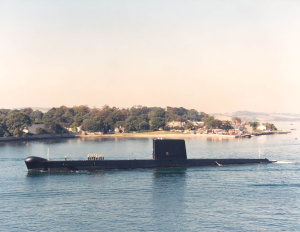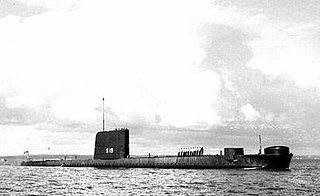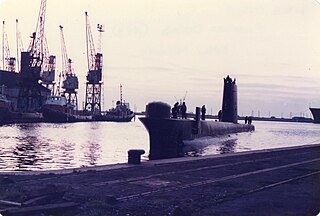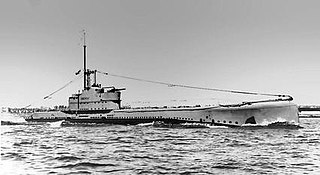
HMS Ocelot (S17) is an Oberon-class diesel-electric submarine which was operated by the Royal Navy.
HMAS Orion was an Oberon class submarine of the Royal Australian Navy (RAN). One of six submarines ordered by the RAN during the 1960s, Orion, named after the constellation in a break from ship-naming tradition, was built in Scotland and commissioned in 1977. Orion was one of two Oberon-class submarines designed for intelligence gathering and conducted regular patrols in Soviet, Indian and Chinese waters to gather information regarding enemy capabilities.

HMAS Ovens is an Oberon-class submarine, formerly of the Royal Australian Navy (RAN). She was one of six Oberons built for the Royal Australian Navy by the Scottish Scotts Shipbuilding and Engineering Company, and entered service in 1969. The vessel was named for Irishman and Australian explorer John Ovens (1788–1825) and for whom the Victorian river Ovens was named. During her career, Ovens was the first RAN submarine to deploy with the ANZUK force, and the first RAN submarine to fire an armed Mark 48 torpedo, sinking the target ship Colac. The boat was decommissioned in 1995, and is preserved at the Western Australian Maritime Museum as a museum ship.

HMS Onyx was an Oberon class submarine of the Royal Navy.

HMS Onslaught was a British Oberon-class submarine operated by the Royal Navy.

HMS Oberon was the lead ship of the Oberon-class submarines, operated by the Royal Navy.

HMS Odin was a British Oberon-class submarine operated by the Royal Navy.

HMS Sealion (S07) was a Porpoise-class submarine.

HMS Opportune (S20) was an Oberon-class submarine of the Royal Navy.

HMS Otus was a Royal Navy Oberon-class submarine launched in 1962. She was decommissioned in the early 1990s and is now a naval museum in Germany.

HMAS Otway was an Oberon-class submarine of the Royal Australian Navy (RAN). One of the first four Oberon-class boats ordered for the RAN, Otway was built in Scotland during the mid-1960s, and commissioned into naval service in 1968. The submarine was decommissioned in 1994. The submarine's upper casing, fin, and stern are preserved at Holbrook, New South Wales.

HMS Olympus was an Oberon-class submarine that served in the Royal Navy, and later in the Canadian Forces as a submarine trainer.

HMS Opossum (S19) was an Oberon-class submarine in service with the Royal Navy from 1964 to 1993.

HMS Cachalot (S06) was a Porpoise-class submarine. Her keel was laid down on 1 August 1955 by Scotts Shipbuilding and Engineering Company at Greenock. She was launched on 11 December 1957, and commissioned on 1 September 1959.

HMS Narwhal (S03) was a Porpoise-class submarine of the Royal Navy. She was launched on 25 October 1957.

HMS Oracle was an Oberon-class submarine of the Royal Navy.

HMS Orpheus was an Oberon-class submarine of the Royal Navy.

HMS Otter (S15) was an Oberon-class submarine of the Royal Navy.

HMAS Oxley was an Oberon class submarine of the Royal Australian Navy (RAN).

HMS Oberon was the prototype for the Odin-class submarine of the Royal Navy.



















